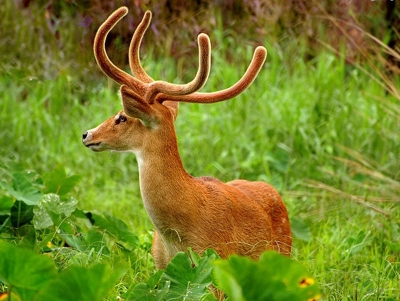
The Sangai, deer, also known as the dancing deer, is found only in Manipur, in India. With about 200 remaining now, the brow-antlered deer has been listed as endangered by the IUCN. While walking on the floating vegetarian (phumdis) in Loktak Lake, the Sangai needs to balance itself which looks like it is dancing, and is hence called ‘dancing deer’.
Shamungao shows a trend in which captive population of the Sangai in all Indian zoos appears to increase exponentially till the 1980s, and after that their numbers begin to fall. He ascribes two reasons for this. “First, overcrowding the animals with low sanitation in the enclosures and, secondly, a possible genetic disorder or deterioration due to long inbreeding with a small population,” says Shamungao. Ranjitsinh corroborates this finding and says that some species of Sangai may have got mixed with other deer species. Similarly, vertebrae ecologist and scientist with the Wildlife Institute of India (WII), A J T Johnsingh, points out that animals for reintroduction should come only from the wild populations in KLNP, as the animals in captivity have reduced genetic diversity. The wild ill-effects of inbreeding can further cause the population of an animal to shrink. That’s why only 24 new Sangais were born during the last decade, according to the forest department’s census. “The slow rate of population growth, high rate of infant mortality and decreased survival are the manifestation of genetic disorders. The inbreeding is commonly associated with a lowering of viability, adaptability and birth weight-a phenomenon known as inbreeding depression,” says Shamungao.
The habitat of the Sangai is already under stress. In 1983, the Manipur government built a barrage for a multipurpose power project on the confluence of the Imphal river, Khuga river and its tributary, the Ungamel channel, south of Loktak Lake. To maintain the water and the power supply, the authorities raised the water height at the reservoir to 762.12 m. A study on Loktaklake by non-profit Kalpavriksh found that KLNP suffered extensively as a result of the raised water level-the park area was constantly inundated by frequent flash floods, especially during the monsoon.
These findings are backed by new research. A recent report by WII researchers, Chongpi Tuboi, Syed Ainul Hussain and Ruchi Badola, reveals that KLNP is facing a phumdi-degeneration rate of nine per cent every year. The researchers have measured maximum thickness of phumdi at 163 cm and the least at 47.44 cm. At the rate of nine per cent, the maximum thickness will be 63.48 cm and minimum at 18.47 cm in 10 years. Hussain says that the construction of the Ithai Barrage is choking the natural process of rejuvenating the floating biomass on which the Sangais thrive.
Credit : Down To Earth
Picture Credit : Google




